Ka-52 Alligator is an all-weather attack helicopter operated by the Russian Air Force. Developed by Kamov Design Bureau (part of Russian Helicopters), Ka-52 is a twin-seat variant of the Ka-50 attack helicopter.
The Ka-52 helicopter can destroy enemy armoured and unarmoured ground targets, low-speed aerial targets and personnel at the frontline and in tactical depth. It is also deployed as a surveillance platform and aerial command post for a group of attack helicopters.
Kamov Ka-50 Hokum: Here
The first Ka-52 helicopter was rolled out in December 1996. The helicopter completed its first flight in June 1997. The serial production of Ka-52 began in 2008 at Progress Arsenyev Aviation plant in the Primorye region of Russia.
Russia plans to equip its proposed Mistral Class amphibious assault ships with Ka-52K helicopters. Ka-52K is a naval variant of the Ka-52 Alligator.
Orders and deliveries of the Russian helicopter
In December 2010, the Russian Air Force’s 334th Tactical Deployment Centre in Torzhok received three Ka-52s. The twin-seat Ka-52 will serve in the air force as a special mission helicopter.
The Russian Air Force began fielding Ka-52 helicopters in April 2011. The Ka-52 will replace the Ka-50 Black Shark fleet that is in service with the Russian Air Force.
Ka-52 design, cockpit and avionics
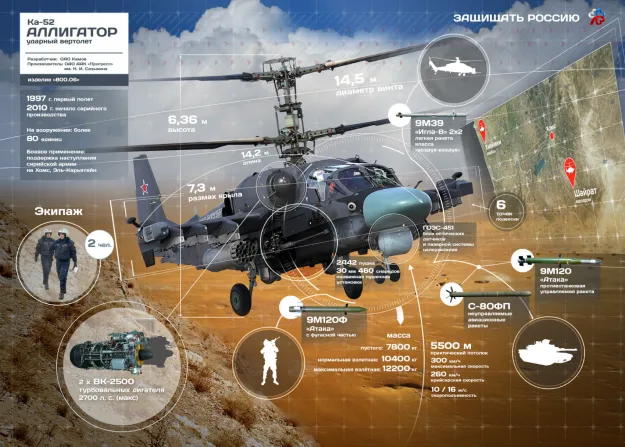
General Information
The Ka-52 Alligator is a next-generation reconnaissance and combat helicopter designed to destroy tanks, armoured and non-armoured ground targets, and enemy troops and helicopters both on the front line and in tactical reserves. The helicopter can operate around the clock and in all weathers. The Ka-52 can provide target acquisition and designation for helicopter teams and ground troop command and control centres. It can also provide fire support for troop landings, fly routine patrols and escort military convoys.
- Ka-52 Alligator is fitted with signature control devices as well as electronic and active counter-measures. It meets the latest Russian and international standards for technical operation of military helicopters.
- The helicopter has a two-seat cockpit and can be flown by either pilot. Its advanced flight capabilities – achieved in part thanks to its coaxial rotors – make the helicopter highly manoeuvrable in limited space and thus able to adopt an advantageous attack position.
- The Ka-52 Alligator’s two VK-2500 turboshaft engines allow the helicopter to operate at altitudes above 5,000m. It has a static ceiling of 4,000m, and is able to take off and land in hot climates and in high mountainous terrain. The Alligator can also operate in cold climates and icy conditions.
- The Ka-52 Alligator is equipped with the latest avionics suite and powerful offensive weapons that can be configured for a wide range of combat missions.
- The Ka-52 Alligator offers a high degree of protection to its crew, advanced automated systems for ease of piloting, and is easy to service and maintain on the ground
Source russianhelicopters.aero
Ka-52 incorporates a slightly modified design of the Ka-50 helicopter. The helicopter features a wider nose and an extended fuselage due to its twin-seat cockpit. The commonality of the airframe, components and systems of the two variants is about 85%.
The helicopter has a length of 16m, height of 4.9m and main rotor diameter of 14.5m. The maximum take-off weight of the Ka-52 is 10,800kg.
Russia’s Alligator attack helicopter’s land version to get folding blades
The land version of the Kamov Ka-52 Alligator (NATO reporting name: Hokum-B) reconnaissance/attack helicopter is expected to get folding blades as part of its upgrade, Russian Helicopters Group, part of Russia’s state hi-tech corporation Rostec, told TASS on Monday.
“As the technique of folding blades has been mastered, a possibility is being considered to use this technology also in the manufacture of the land version of this helicopter’s modification,” the Russian Helicopters press office said.
The helicopter’s modernization has already begun. This innovation will make it possible to keep this helicopter at hangars, which gives the Alligator’s land version a fundamental advantage, the press office said.
Russian Deputy Defense Minister Yuri Borisov earlier said that Ka-52 Alligator helicopters could be modernized considering the experience of their combat use in Syria.
According to the deputy defense minister, the Ka-52 has proved its worth in combat operations in Syria. Source tass.com
Cockpit
 Defense Tech Russia YoTube
Defense Tech Russia YoTube
The twin-seat cockpit accommodates two crew members in side-by-side arrangement. Both the crew members are seated on identical K-37-800M ejection seats.
K-37-800M ejection seats
 zvezda-npp.ru
zvezda-npp.ru
CAS K-37-800M consists of two parts – an armchair and a side part, designed to perform the functions of the pilot’s seat of the Ka-50 and Ka-52 helicopter and providing in combination with the ZSh-7VS helmet and oxygen equipment of the KCO-VK-LP safe emergency exit by bailout with the help of a towing rocket engine at an indicated flight speed from 90 to 350 km / h in the altitude range from 0 to 5000 m and reducing the loads acting on the pilot during an emergency landing using the energy-absorbing cushioning suspension of the chair.
 arronlee33 YouTube
arronlee33 YouTube
For two-seat aircraft, it is possible to dilute the trajectories of pilots and their parachutes with simultaneous bailouts.
CAS is available in several versions.
CAS is combined:
- with flight clothing (summer, demi-season and winter);
- with on-board oxygen equipment KCO-VK-LP;
- with a protective helmet ZSh-7VS (ZSh-7V), including with the ONV;
- with NAZ-Ir;
- with the marine rescue kit MSK-5;
- with the air rescue belt ASP-74;
- with the apparatus of underwater breathing APD from the kit of rescue equipment KSS.
 Телеканал Звезда
Телеканал Звезда
Main technical characteristics:
- The range of bailout rates from 90 to 350 km / h
- Range of bailout heights from 0 to 5000 m
- The total weight of the pilot’s equipment is from 6.5 to 12.8 kg.
- Allowed pilot parameters from 57.0 to 91.4 kg; growth sitting from 810 mm to 980 mm.
- The weight of the seat of the system with pyrocharges is not more than 57.25 kg.
Year of development: 2007
Application:
Ka-52, Ka-52K
Source zvezda-npp.ru




 twoover.livejournal.com
twoover.livejournal.com twoover.livejournal.com
twoover.livejournal.com twoover.livejournal.com
twoover.livejournal.com
Cockpit armor
From the book of A. Mazepov, A. Mihkaev, V. Zenkin, A Zhirnov and A. Fomin about the Ka-50 called Polygon from 1996, on Page 31, there is said how the Armor was made on Ka-50 and after that also installed on Mi-28.
It is a 3 hardlinered armor, the inner cockpit section made of a full single titanium alloy “bathtub” covering both pilots, followed by a middle liner of ceramic plates, which caused trouble first after a single shot they break apart and lost all its protective abilities, they avoided that by covering this ceramic plates with kevlar/aramid that was glued on tightend and the outer liner which gives the aerodynamic shape and is made of alluminium alloy with a part carbon in it. The total armor per pilot for russian Ka-50 which they could use was about 300kg while the Apache uses about 90kg of armor per pilot. The Mi-28 has about 250-280kg which was mentioned somewhere else. The Ka-52 has less armor than both Mi-28 and Ka-50 spend for each pilot but it is still in the figure of 150-200kg. Source: Russian Defense
The modern glass cockpit is equipped with a head-up-display (HUD), four SMD 66 multifunction displays, helmet-mounted sight display, image intensifiers and a GPS receiver. The helicopter also integrates a FAZOTRON cabin desk radio-locator and navigation and attack system for helicopters (NASH).
Helmet-mounted sight display
In September 2012 Russian Helicopters, a subsidiary of Oboronprom, signed a long-term contract with Ramenskoye Design Company (RDC) for deliveries of avionics equipment. As part of the contract, RDC is responsible for the supply of avionics packages for Ka-52 attack helicopter and Ka-52K advanced ship-based variant between 2013 and 2020.
Ka-52K helicopter design and features
The new ship-borne Ka-52K is based on the airframe of the Ka-52 Alligator, which itself is a modified variant of the Ka-50 attack helicopter. The fuselage is covered with resilient anti-corrosion coating and is fitted with folding blades and wings.
 Kamov Ka-52 ‘Aligator’ (left) and Kamov Ka-52K ‘Katran’ (right) – charly015.blogspot.com
Kamov Ka-52 ‘Aligator’ (left) and Kamov Ka-52K ‘Katran’ (right) – charly015.blogspot.com
The equipment and systems of the helicopter have been modified to suit naval operations.
The rotor system is equipped with elastomeric bearings in blade-mast joints for higher take-off weights. The helicopter complies with the latest Russian and international standards for technical operation of military helicopters.
 Ka-52K – RussianDefence.com
Ka-52K – RussianDefence.com
The helicopter features an advanced glass cockpit, which accommodates two pilots in side-by-side layout. It can be operated by either pilot and is equipped with advanced avionics and powerful weapon systems, which can be configured for different roles.
The onboard avionics with the use of radio equipment and satellite navigation ensure autonomous landing on the ship deck, and the onboard equipment further makes the helicopter a network-centric system for interaction between the Navy and Air Force.
 Ka-52K – RussianDefence.com
Ka-52K – RussianDefence.com
The helicopter is also integrated with an air-conditioning system for conducting missions in the humid marine atmosphere.
Ka-52K sensors / radars
The Ka-52K is equipped with a laser-beam guidance system and Okhotnik video processing system developed by KRET.
Okhotnik provides the helicopter with increased range of detection and identification, while the auto-tracking stabilises the video field on the target and transmits a digital error code in case of a mismatch between the display coordinates and the line of sight.
The onboard Arbalet radar system allows the helicopter to effectively perform combat missions even in environments exposed to electronic jamming. The helicopter can detect hostile vessels at a range of 200km.
The ship-based helicopter is equipped with Vitebsk defence system, SAU-800 automatic control system and GOES-451 gyro-stabilised optronic station.
The SAU-800 enables the pilots to operate the helicopter in manual, automated, and automatic control modes. It is integrated with the SIVPV-52 data recording and processing system developed by Radioelectronic Technologies.
Ka-52K attack helicopter poised for AESA radar upgrade
 MF2 Radar? – vitalykuzmin.net
MF2 Radar? – vitalykuzmin.net
The navalised variant of the the Kamov Ka-52 Alligator (Hokum-B) attack/reconnaissance helicopter – the Ka-52K Katran – will be equipped with a compact active electronically scanned array (AESA) radar from Russian defense contractor Radio-Electronic Technologies (KRET), a company spokesperson told IHS Jane’s .
KRET claims that its AESA radar will be able to operate in the millimetric wavelength for effective ground target acquisition as well as the centimetric spectrum to enable large naval targets to be detected at a range of 180 km.
The radar is also capable of detecting low-altitude aerial targets such as cruise missiles and unmanned aerial vehicles (UAVs), providing data to cue onboard electro-optical devices and corresponding weapons to these targets.
Flight safety is enhanced with ground moving target indication and tracking modes, which assists the crew in coping with low visibility conditions such as fog, dust and night-time operations. The radar also detects ground obstacles including transmission towers and power lines.
The Ka-52K helicopter – developed to sink amphibious landing ships as well as the transports of enemy strike groups and convoys with its ability to employ anti-ship cruise missiles such as the high-speed Kh-31AD – was originally slated for deployment aboard the two French-built Mistral-class amphibious command ships originally destined for the Russian Navy.
However, delivery of the ships to Russia had subsequently been cancelled by France due to the former’s annexation of Crimea.
There are now plans to add the helicopters already constructed to the air wing of the Project 11435 Admiral Kuznetsov aircraft carrier. Posted on 08 August 2016 janes.com
Optoelectronic System OES-52 for KA-52K Helicopter
The composition of ECO-52:
• Optical-mechanical unit (BOM-52);
• information processing unit (BOI-52);
• power supply unit (BP-52);
• Optical-digital switch (BCC);
• module of electronic laser guidance system (ME LSM);
• the module of an electronic laser-beam control channel (ME LLKU);
• set of cables.
Main functions:
• Providing round-the-clock search, detection and recognition by the operator of the on-board video indicator on the screen of the on-board, surface and low-speed air targets;
• measurement of the angular coordinates of the line of sight;
• capture and tracking of targets or areas of the terrain;
• measurement of the inclined range to the target or point of the terrain, measurement of the relative velocity;
• laser target illumination;
• search, detection and automatic tracking of the target, illuminated by laser radiation from an external ground or aircraft illuminator;
• targeting of guided missiles of various types;
• Ensuring the mutual alignment of channels and automatic built-in control.
Source npk-spp.ru
Ka-52K weapon systems
The helicopter carries a 2A42-1 30mm automatic cannon and high-fragmentation, explosive incendiary, or armour-piercing rounds.
The gun has a maximum rate of fire of 550 rounds a minute and can engage light armoured targets within the range of 1,500m, soft-skinned targets and infantry at ranges up to 4,000m, and air targets flying at low altitudes.
The Ka-52K is also capable of launching Kh-31 and Kh-35 air-to-surface missiles, similar to carrier-based MiG-29K/KUB multipurpose fighter jets and Sukhoi Su-33 (Flanker-C) aircraft. source naval-technology.com
Kh-31 air-to-surface missiles
 httproe.ru
httproe.ru
The Kh-31A high-speed anti-ship airborne missile is designed to engage warships of different type, including destroyers, navigating both autonomously and within naval attack groupings.
The Kh-31A missile can be effeciently launched either independently or in salvo, in fair and adverse weather, clutter and active jamming conditions, against preplanned targets and targets of opportunity.
The missile is equipped with a high-precision active radar homing head and a radio-altimeter. The active radar homing head can operate in the pre-launch and en route (post-decent) target designation modes. It ensures target acquisition and selection, determination of target coordinates (range, azimuth, elevation), generation of command signals and their feeding into the missile’s guidance system.
Thanks to its relatively small weight and size the Kh-31A missile can be employed from various air combat platforms, including moderately sized ones. The missile has passed state acceptance tests on a number of series-production front-line combat aircraft of the Russian Air Force. It makes part of weapon systems of modern combat aircraft, such as the Su-25, Su-27, Su-30, Su-34, MiG-29, etc., and can be adapted to other types of Russian or foreign-origin aircraft during their modernization.
The Kh-31A missile is suspended under the carrier aircraft with necessary links to its onboard systems, carried in flight and launched (or jettisoned in emergency, if required) by means of the AKU-58A missile ejection unit.
Developer and manufacturer: Tactical Missiles Corporation @ktrv.ru
Performance:
| Launch altitudes envelope, km | 0,1-10(15) |
| Launch speeds envelope, km/h | |
| (Mach number) | 600-1,250 (0,65-1,5) |
| Max launch range | |
| (against destroyer-type targets from | |
| altitude of 10/15 km), km | 50/70 |
| Max missile cruising speed, m/s | 1,000 |
| Warhead weight, kg | 94 |
| Missile launch weight, kg | about 610 |
| Missile dimensions, m: | |
| length | 4,7 |
| body diameter | 0,36 |
| wing span | 0,914 |
Source ktrv.ru
Kh-35 air-to-surface missiles
The Kh-35E (3M-24E) anti-ship missile is designed to destroy surface warships displacing up to 5,000 tonnes, as well as seagoing transports.
The Kh-35E unified guided missile can be launched from the following platforms:
– Uran-E type ship-borne missile systems;
– Bal-E type mobile coastal missile systems;
– tactical and naval combat aircraft.
The Kh-35E anti-ship missile can be employed in fair and adverse weather conditions at Sea States up to 5-6, by day and night, under enemy fire and electronic countermeasures.
The Kh-35E’s aerodynamic configuration is optimized for high subsonic-speed sea-skimming flight to ensure stealthy characteristics of the missile.
Target acquisition and designation data can be fed into missile’s guidance system from both ship-based and external target data sources.
The missile has low signatures thanks to its small dimensions, sea-skimming capability and a special guidance algorithm ensuring highly secure operational modes of the active radar seeker.
Its ARGS-35E active radar seeker operates in both single- and multiple-missile launch modes, acquiring and locking on targets at a maximum range of up to 20 km.
Developer and manufacturer: Tactical Missiles Corporation Source ktrv.ru
Performance:
| Launch range, km | up to 130 |
| Flight altitude, m: | |
| en route | 10-15 |
| at terminal area | about 4 |
| Cruise speed, Mach number | 0,8 |
| Max missile turn angle, ang.deg.: | |
| in horizontal plane after launch | +;- 90 |
| Missile launch weight, kg: | |
| ship/land-based versions | 620/620 |
| aircraft/heliborne versions | 520/610 |
| Warhead type | HE penetrator |
| Warnead weight, kg | 145 |
| Missile dimensions,m: | |
| length of ship/land-based | |
| and heliborne versions | 4,4 |
| length of airborne version | 3,85 |
| body diameter, m | 0,42 |
| wing span | 1,33 |
Source ktrv.ru
Ka-52 Alligator armaments on the attack helicopter
The starboard side of the fuselage is fitted with a NPPU-80 movable gun mount installed with 2A42 30mm automatic gun. The six wing-mounted external hardpoints can be attached with different combinations of weapons.
2A42 30mm automatic gun
 2A42 30mm automatic gun with a NPPU-80 movable gun mount – bastion-kerpenko.ru
2A42 30mm automatic gun with a NPPU-80 movable gun mount – bastion-kerpenko.ru
The 30mm automatic gun is designed for firing at light armored targets within a distance up to 1500 m, non-armored targets within a distance up to 4000 m and also at low-flying subsonic air targets up to 2000 m within a slant distance of 2500m. The gun can be fired in single shots or in burst (low or high rate of fire). It offers reliable functioning under severe conditions, such as temperature range from +50°C up to -50°C, in rain, dust, frost and in very dry environment.
 Минобороны России
Минобороны России
TECHNICAL DATA OF 2A42
| Caliber | 30 mm | |
| Number of grooves | 16 | |
| Twist of grooves | 715,5 mm | |
| Rate of fire | high | min 550 rounds/min |
| low | 200-300 rounds/min | |
| Gun weight | 115 kg | |
| Barrel weight | 38,5 kg | |
| Recoiling force | 40-50 Kn | |
| Length of the gun | 3 027 mm | |
| Voltage of the trigger electric source, contact system | 27 +2/-5 V | |
| Feeding | Two belt type | |
| Recocking | Pyrotechnical or manual | |
| Number of powder cartridges | 3 | |
| Force required to cock the gun by hand for: | ||
| – loading | up to 400 N | |
| – re-loading with simultaneous extraction of misfired round | up to 600 N |
source ztsspecial.sk
The hardpoints can carry VIKHR anti-tank guided missiles (ATGM), ATAKA missiles with laser guidance system and B8V-20 rocket launchers for 80mm unguided S-8 rockets. VIKHR anti-tank missile has a range of eight to ten kilometres. The Ka-52s can also be armed with IGLA-V anti-aircraft guided missiles.
VIKHR anti-tank guided missiles (ATGM)
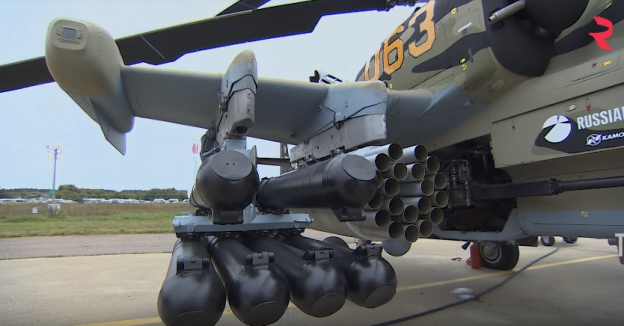 VIKHR anti-tank guided missiles (ATGM) – RUSSIA BEYOND
VIKHR anti-tank guided missiles (ATGM) – RUSSIA BEYOND
The 9A4172 Vikhr is a Russian long-range anti-tank guided missile. It is known in the West as the AT-16 or Scallion. It was developed in the Soviet Union during the 1980s. At the time Soviets needed a new missiles, to replace the 9K114 Shturm (Western reporting name AT-6 or Spiral) system, that could penetrate contemporary Western main battle tanks with composite and explosive reactive armor, such as the American M1 Abrams, German Leopard 2, and British Challenger. Prototypes were tested by the Soviet armed forces in 1989. First production missiles were delivered in 1992. During the same year the Vikhr was first publicly revealed. Since its introduction sales of the Vikhr missile have been slow, partly because Russia also uses Ataka missile, developed by another manufacturer, which is similar in function, but uses different guidance. In 2013 Russian MoD ordered over 6 000 Vikhr-1 missiles in order to prevent the manufacturer from going bankrupt. Delivery of these missiles commenced in 2015 and was completed in 2016. The Vikhr has been exported to Egypt, and possibly some countries. Source military-today.com
ATAKA missiles with laser guidance system
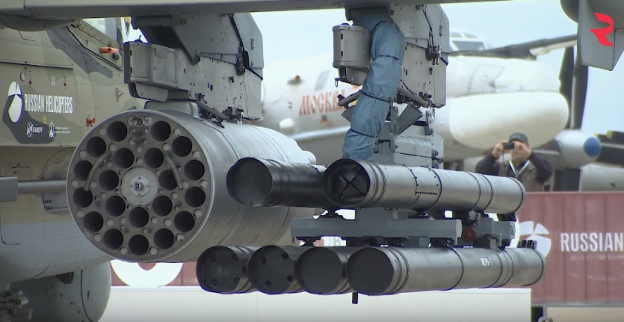 ATAKA missiles with laser guidance system (right) – RUSSIA BEYOND
ATAKA missiles with laser guidance system (right) – RUSSIA BEYOND
The Ataka (Attack) (Western reporting name AT-9 Spiral-2) is a long-range anti-tank guided missile system. It was developed in the 1980s in the Soviet Union as a follow-on to the previous Shturm (AT-6 Spiral) system, that was introduced in 1976. Soviets needed a new missiles, that could defeat contemporary Western main battle tanks with composite and explosive reactive armor, such as the American M1 Abrams, German Leopard 2, and British Challenger. Launchers with Ataka missiles can be mounted on helicopters, vehicles and watercraft. It is basically similar to the previous Shturm, but has longer range and is more resistant to electronic countermeasures. The Ataka missiles are currently used by the Russian armed forces. These missiles have been exported to Algeria, Brazil, India, Kazakhstan, and Slovenia. Some sources report that these missiles have also been exported to Iran and North Korea.
The Ataka can be fired from existing Shturm launch platforms, such as a Shturm-S anti-tank missile carrier, without any modifications. It is used on attack helicopters, such as the Mi-24, Mi-28, and Ka-52, though it can be also carried by transport helicopters. Source military-today.com
IGLA-V anti-aircraft guided missiles
The 9K38 Igla (Needle) is a Man-Portable Air Defense System (MANPADS) developed by Soviet Union in the 1970s. It succeeded the older Strela-3 with better range and seeker sensitivity. The system uses an 9M39 Surface-to-Air missile (SAM). It was adopted by the Soviet Army in 1981. This air defense system is known in the West as SA-18 Grouse. The Igla MANPADS can engage aircraft, helicopters and UAVs.
Comparing with the Strela series, the Igla has increased warhead weight. Its infrared guidance system uses proportional convergence logic for target acquisition and movement prediction.
The 9M39 missile constitutes a seeker head, control system and propulsion system. The 9E410 seeking head contains photo resistor sensor made of Indium cooled down to -200 degree Celsius for better IR source acquisition. The seeker head also contains logical selection unit to enhance system’s acquisition capability during target engagement. The Igla also uses 9S520 night fire equipment package. Source military-today.com
 White Day YouTube
White Day YouTube
Hermes-A extreme-range anti-tank guided missile (ATGM) system
 bastion-karpenko
bastion-karpenko
The products are able to hit targets at a distance of up to 30 km, while the most effective helicopter ATGMs – Attack, Vortex and Hellfire – do not exceed 10 km. According to experts, the use of “Hermes” in Syria will not only test the unique missile system in battle, but also demonstrate the novelty to potential buyers, especially Egypt.
Development and testing of the newest ATGM the Tula Design Bureau of Instrument Engineering has been conducting since the mid-1990s. Despite the fact that “Hermes” is officially called an anti-tank missile, it is a universal product capable of hitting a wide range of targets, including structures, field fortifications and the enemy’s living force.
As the editor-in-chief of the Internet project Militaryrussia Dmitry Kornev told Izvestia, the latest Hermes missile is equipped with a combined guidance system capable of detecting enemy targets even in the most difficult weather conditions.
– On the “Hermes” is a combined homing head (GOS) with an infrared sensor and a laser guidance channel, “says Kornev. – The purpose of the rocket can be “illuminated” from the ground. That is, an air racer, a helicopter or an airplane will aim the laser beam at the target, and the GOS “Hermes” will “see” the laser spot and take the target. But if the laser does not have a backlight, then infrared sensors come into effect, which will detect enemy targets for the heat generated. In the future, miniature radar stations can appear on the Hermes missiles, which, combined with infrared guidance, will ensure the unique accuracy of the latest products.
According to the expert, the speed of the Russian guided missile is close to hypersonic.
“The two-stage design of Hermes is largely unified with the design of the anti-aircraft missile of the Pantsir-S complex,” says Kornev. – The starting stage disperses the missile and leads to the target area, after which it is separated from the product. Then the battle bloc enters the case, which is already searching for the target, and then destroys it. The minus of this layout is the large weight of the rocket. According to available data, the product weighs more than 90 kg, while the “Vortex” ATGM is twice as light. Source vpk.name
Number of Stages: 2
Dimensions
Diameter: 170 millimeter (6.69 inch)
Length: 3.50 meter (138 inch)
Performance
Max Range: 20 kilometer (10.8 nautical mile)
Speed
Cruise Speed: 500 mps (1.51 mach)
Top Speed: 1,000 mps (3,601 kph)
Weight
Warhead: 28 kilogram (62 pound)
Weight: 110 kilogram (243 pound)
Source deagel.com
B8V-20 rocket launchers
 Телеканал Звезда
Телеканал Звезда
Technical specifications:
| Type |
B8V20-A |
B8M1 |
| Quantity of tubes, pcs. |
20 |
20 |
| Calibre, mm |
80 |
80 |
| Pod management |
electrical |
electrical |
| Weight of pod withoit rockets S-8-type |
100 |
150 |
| Weight of loaded pod, kg |
342 |
395 |
| Dimensions, mm |
1 793x521x578 |
2 760x520x594 |
Source spetstechnoexport.com
 White Day YouTube
White Day YouTube
Ka-52 Alligator sensors, radars and countermeasures
 Defense Tech Russia YoTube
Defense Tech Russia YoTube
The Ka-52 helicopter is fitted with a mast-mounted radome nose mounted housing a Phazotron FH-01 Millimeter Wave Radar (MMW) radar with two antennas for aerial and ground targets.
Phazotron FH-01 Millimeter Wave Radar (MMW) radar
 arronlee33 YouTube
arronlee33 YouTube
The Arbalet radar station created by Fazotron NIIR, part of Radioelectronic Technologies, allows the Ka-52 helicopter to effectively complete combat missions at any time of day or night in all weather conditions, even in the presence of organized or natural electronic jamming. The radar station provides Ka-52 pilots with a radar map of an area, which allows dangerous meteorological formations and zones of turbulence to be detected and avoided, while targets for destruction can be quickly located.
Another of Radioelectronic Technologies’ facilities – the Ryazan State Instrument-making Enterprise – is the manufacturer of the Ka-52’s laser-beam guided weapon navigator and video image processing system from the Hunter range, used for missile guidance. These systems allow the helicopter to quickly detect and track two targets at the same time, carrying out high-precision guidance of Attack and Vortex missiles. Source rostec.ru
Arbalet-M, Arbalet 52
More capable version of Arbalet, using Baguet series processor. Designed for the Ka-52.
- Data processor: Ts181F
- Signal processor: Baget-55-04.01
- MTBF: 150 h
- Total weight: 140kg
Air-to-surface modes
- Various mapping modes
- Moving Target Selection of ground and air targets
- Determination of priority of objects
- Determination of terrain contours and obstacle detection during low-altitude flight
- Missile approach warning
- Support/cueing of EO targetting systems
- Detection of dangerous weather formations
- Navigation systems update/correction
- Missile and rocket control
- Target type classification (in conjunction with IFF)
- Azimuth coverage: 120°
- Mapping range: 32 km
- Range of detection of ground target: bridge: 25 km, tank: 12 km
- Measurement precision: azimuth: 12 min, elevation: 17 min, distance: 20 m
- Range of detection of ground-based obstacles and terrain detection/avoidance- Electricity cables: 0.4 km, 10° sloping terrain: 1.5 km
- Tracks 20 targets at once
Air-to-air modes
- Search limits, azimuth: 360°, elevation ±30°
- Detection range for Attack aircraft: 15 km, Stinger missile: 5 km
- Tracking limits, azimuth: ±60°, elevation: ±30°
- Tracks up to 20 targets
Source aerospace.boopidoo.com
| GENERAL DATA: | |
|---|---|
| Type: Radar | Altitude Max: 0 m |
| Range Max: 37 km | Altitude Min: 0 m |
| Range Min: 0.2 km | Generation: Early 2000s |
| Properties: Periscope/Surface Search – Advanced Processing [2000+], Pulse Doppler Radar (Full LDSD Capability) |
| SENSORS / EW: |
|---|
| Ka-52 Nose Radar – Radar Role: Radar, FCR, Air-to-Air & Air-to-Surface, Short-Range Max Range: 37 km |
Source cmano-db.com
SUO-806P weapons control complex
 Weapon control system 806P for Ka-52 – vitalykuzmin.net
Weapon control system 806P for Ka-52 – vitalykuzmin.net
The SAU-800 automatic control system, created by Radioelectronic Technologies’ facilities in Saratov – the Industrial Automatics Design Bureau – enables the Alligator to be piloted in manual, automated and automatic modes. The SAU-800 is integrated with the SIVPV-52 aerometric data recording and processing system developed by Radioelectronic Technologies’ Moscow-based company Aeropribor Voskhod.
The SUO-806P weapons control complex for the Ka-52 has been designed and produced by Radioelectronic Technologies’ Kursk-based Aviaavtomatika company (Kursk OJSC Pribor). Source rostec.ru
GOES-451 gyro-stabilised optronic station
Телеканал Звезда
| GENERAL DATA: | |
|---|---|
| Type: Visual | Altitude Max: 0 m |
| Range Max: 83.3 km | Altitude Min: 0 m |
| Range Min: 0 km | Generation: LLTV, 3rd Generation (2000s/2010s) |
| Properties: Identification Friend or Foe (IFF) [Side Info], Classification [Class Info] / Brilliant Weapon [Automatic Target Aquisition], Continous Tracking Capability [Visual], LLTV / NVG / CCD (Night-Capable) / Searchlight [Visual Night-Capable] |
| SENSORS / EW: |
|---|
| Generic LLTV – (3rd Gen, Weapon Director & Target Search, Tracking and Identification) Visual Role: LLTV, Weapon Director & Target Search, Tracking and Identification Max Range: 83.3 km |
Source cmano-db.com
FLIR
| GENERAL DATA: | |
|---|---|
| Type: Infrared | Altitude Max: 0 m |
| Range Max: 55.6 km | Altitude Min: 0 m |
| Range Min: 0 km | Generation: Infrared, 3rd Generation Imaging (2000s/2010s, Impr LANTIRN, Litening II/III, ATFLIR) |
| Properties: Identification Friend or Foe (IFF) [Side Info], Classification [Class Info] / Brilliant Weapon [Automatic Target Aquisition], Continous Tracking Capability [Visual] |
| SENSORS / EW: |
|---|
| Generic FLIR – (3rd Gen, Weapon Director & Target Search, Tracking and Identification FLIR) Infrared Role: Infrared, Weapon Director & Target Search, Tracking and Identification FLIR Max Range: 55.6 km |
Source cmano-db.com
Laser Target Designator & Ranger (LTD/R)
| GENERAL DATA: | |
|---|---|
| Type: Laser Designator | Altitude Max: 0 m |
| Range Max: 18.5 km | Altitude Min: 0 m |
| Range Min: 0 km | Generation: Not Applicable (N/A) |
| SENSORS / EW: |
|---|
| Generic Laser Designator – (Surface Only) Laser Designator Role: Laser Target Designator & Ranger (LTD/R) Max Range: 18.5 km |
Source cmano-db.com
The countermeasures are supported by active IR and electronic jammers, radar warning receiver (RWR), laser detection system, IR missile approach warning sensor and UV-26 flare / chaff dispensers in wing-tip fairings.
“Vitebsk” BKO-L-370B52 (for Ka-52)
 Helicopter with BKO “Vitebsk” / Photo: topwar.ru
Helicopter with BKO “Vitebsk” / Photo: topwar.ru
It is designed to protect aircraft from anti-aircraft missiles with infrared, radar or combined homing heads. “Vitebsk” is able to track the launch of missiles within a radius of several hundred kilometers from the aircraft and “take away” the missile from the target.
It is designed to protect aircraft from anti-aircraft missiles with infrared, radar or combined homing heads. “Vitebsk” is able to track the launch of missiles within a radius of several hundred kilometers from the aircraft and “take away” the missile from the target.
 Composition of the base complex “President-C” / Image: www.russianarms.ru
Composition of the base complex “President-C” / Image: www.russianarms.ru
Structurally, the complex L-370 “Vitebsk” is made in the form of blocks that can be located inside the fuselage and on the outer hinges of the aircraft or helicopter. The main elements of the complex are laser radiation detection equipment, ultraviolet rocket launching direction finder, control system, opto-electronic suppression station and false thermal targets (LTC) devices. The known modifications of BKO-L-370B52 (for Ka-52), L-370E8 (for MI-8MT), L-370E26L (for MI-26), L-370E50 (for Ka-50).
 Station of active interference L-370-3S – bastion-kerpenko.ru
Station of active interference L-370-3S – bastion-kerpenko.ru
The main element of Vitebsk is the digital station for active interference (LSS) L-370-3S. It exceeds the Sorbtsiya (Su-27), Omul (Su-25), Gardenia (MiG-29) and suppresses the enemy radar in a wider frequency range. The complex includes a system of protection against missiles with a thermal homing head (TGSN), which blinds enemy missiles with a laser spotlight. Translated by google – source arms-expo.ru
SPO-32 / L150 Pastel digital receiver
Pastel entered development in 1982, possibly as a reaction to poor performance of Soviet fighters in the Middle East. By 1983 the initial design was produced. It was intended for the Mi-28, MiG-29K/M, Su-27M and others.
Pastel is a family of new generation digital RWRs.
Su-25TM installation
Scans from 1.2-18GHz threat frequencies.
Accuracy is 3-5° with pinpoint location antenna, 10° in rough location antenna. 128 reprogrammable radar types. Detection range minimum of 120% of the radar’s range. 3 modes- operational target, programmed target, most dangerous target.
Detects and finds direction for pulse, pulse-doppler and CW mode radars in search, track and illumination modes. Classifies multiple threats by danger, with full display of all information about most threatening radar presented to crew. Controls EW systems, has the ability to control and assign targets to 6 anti-radiation missiles such as the Kh-31. Aural warnings for high threat situations.
Pastel may be made available for upgrade packages or built into new export models of the Mig-29 and Su-27 families. Source aerospace.boopidoo.com
| General data: | |
| Type: ESM | Altitude Max: 0 m |
| Range Max: 222.2 km | Altitude Min: 0 m |
| Range Min: 0 km | Generation: Early 2000s |
| Sensors / EW: |
| SPO-32 Pastel [L-150] – ESM Role: RWR, Radar Warning Receiver Max Range: 222.2 km |
Source cmano-db.com
UV-26 flare / chaff dispensers
It is intended to protect aircraft and helicopters against guided missiles by jamming their guidance systems and actuators in the optical and radio wavelengths of electromagnetic waves. The composition of the device – control unit, control unit, power switches, emission units (of embodiment A or B). Option device depends on the type of aircraft to equip. Operating modes – manual, auto, fast shooting, the built-in control. The device operates as part of the on-board or off-defense complex. Parameters shooting programs – volley, series, series interval sequence, the interval sequence. The shooting noise is produced from the left, right or on both sides simultaneously. Provides compensation for single and multiple combat damage, faults (with the implementation of a given program). Output digital display of the current availability of cartridges – on the remote control or on-board LED. Source vympelmkb.com
L418-5 DIRCM
APU
APU is on the right side aft of engine as in above picture
Engines and performance of Russia’s Ka-52
 arronlee33 YouTube
arronlee33 YouTube
The Ka-52 Alligator is powered by two Klimov VK-2500 turboshaft engines driving two coaxial contra-rotating main rotors. Each engine produces a maximum take-off power of 2,400hp. The engines are equipped with a new full authority digital control system (FADEC).
2 x VK-2500
Improved Safety
Should one of he engines fail, the flight safety is greatly enhanced owing to the emergency power feature (2700 hp) of the VK-2500 engine.
Flexible power options and trouble-free maintenance
The engine can be adjusted to use any of the three horsepower options available depending on the customer’s preference. This choice helps take full advantage of the helicopter’s features as well as save fuel.
 arronlee33 YouTube
arronlee33 YouTube
FACTS
-
Developed in 2001
-
Power class – 2500 hp
-
Installed on modified Mi-17 and Ka-32 helicopters, as well as on Mi-28, Ka-52 and Mi-35 modern fighter helicopters
-
VK-2500 engines are installed on helicopters that serve mountain rescue units of the Russian Ministry of Emergency Situations.
-
VK-2500 engines as components of a MI-17-V5 power plant passed tests in the mountains of Tibet.
-
The service life of a VK-2500 may reach 9,000 hours.
-
A perfect upgrade for helicopters equipped with TV3-117 engines.
Principal specifications of the VK-2500 engine:
| Horsepower options | I | II | III |
| Emergency performance (Н=0, V=0): | |||
| power (ISA+150С), hp | 2700 | 2700 | 2700 |
| Takeoff performance (Н=0, V=0): | |||
| power (ISA+30/25/150С), hp | 2000 | 2200 | 2400 |
| specific fuel consumption, (ISA), g/hp/hr, no higher than | 220 | 214 | 210 |
| Cruising performance (Н=0, V=0): | |||
| power (ISA+25/25/150С), hp | 1500 | 1500 | 1750 |
| Dimensions, mm: | |||
| Length | 2055 | 2055 | 2055 |
| Width | 660 | 660 | 660 |
| Height | 728 | 728 | 728 |
| Weight, kg | 300 | 300 | 300 |
Source klimov.ru
 arronlee33 YouTube
arronlee33 YouTube
The Ka-52 helicopter can fly at a maximum altitude of 5,500m. The maximum and cruise speeds of the helicopter are 300km/h and 260km/h respectively. The helicopter can climb at a rate of 12m/s. The Ka-52 has a practical flight range of 460km, while its ferry flight range is 1,110km.
Specification
| FLIGHT CAPABILITIES | |
|---|---|
|
Static ceiling
|
Up to 4,000m
|
|
Operational ceiling
|
5,500m
|
|
Engines
|
2 x VK-2500 or VK-2500P
|
|
Take-off power
|
2 x 2,400hp
|
|
Maximum acceleration at sea level
|
16m/s
|
|
Vertical acceleration at sea level
|
12m/s
|
|
Maximum speed
|
300km/h
|
|
Cruising speed
|
260km/h
|
|
Ferry range
|
1,100km
|
|
Practical range (internal fuel tanks)
|
460km
|
| MAIN ARMAMENTS | |
| The Ka-52 Alligator is equipped with 30mm calibre 2A42-1 aircraft gun, and can also carry a Strelets missile system, launch systems for guided missiles such as Ataka and Vikhr-1, as well as a launch system for S-8 unguided missiles. | |
| EMERGENCY SYSTEMS | |
| K-37-800M shock-absorbing ejector seats | |
Specification russianhelicopters.aero
Main material source airforce-technology.com
Images are from public domain unless otherwise stated
Main image Vladislav Perminov @flickr
Revised Sep 30, 2018
Updated Jan 27, 2020











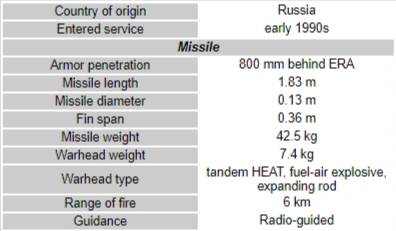














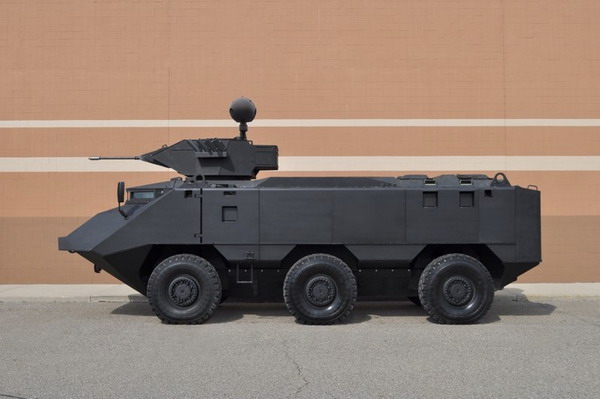



 Desert Chameleon 8×8
Desert Chameleon 8×8


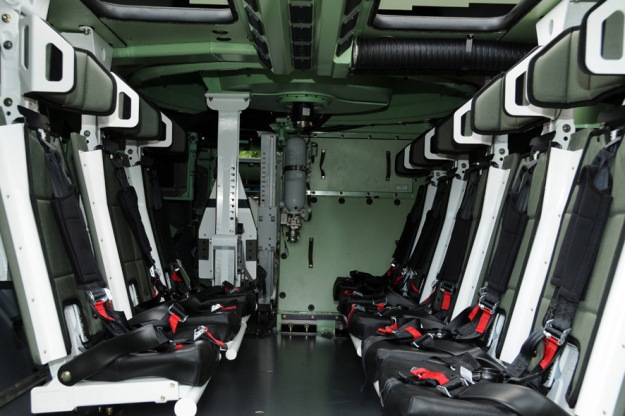


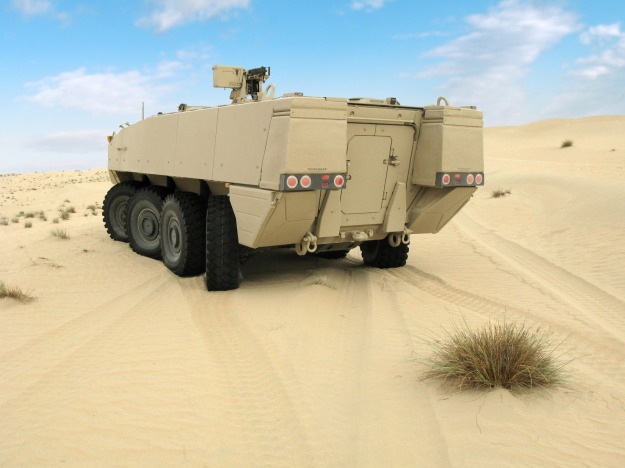
 Piranha V being loaded onto an Airbus A400M
Piranha V being loaded onto an Airbus A400M 














































